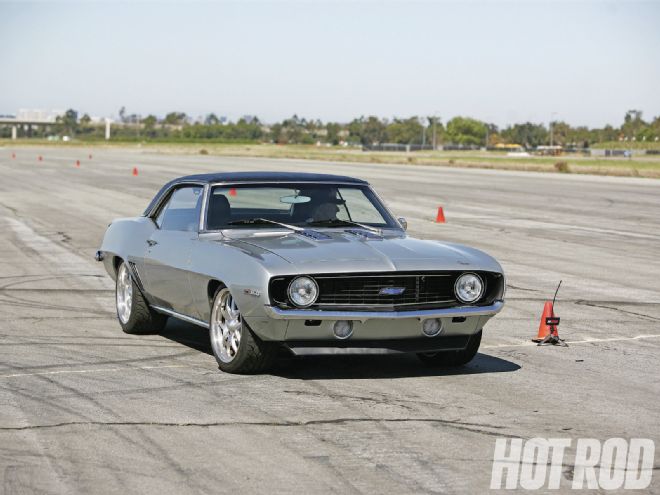
The first electronic antiskid braking systems (ABS) were introduced 25 years ago. Since then the original ABS setups have evolved from basic systems designed to combat wheel lockup and skidding under braking into traction control systems that also prevent wheelspin under acceleration. By the late ’90s, some high-performance sports cars morphed the technology even further, introducing electronic stability control (ESC) that automatically brakes individual wheels as needed for improved handling and steering control. ESC is so effective in preventing accidents that the Feds have mandated that every new U.S. car and truck be equipped with ESC by 2012. Yet all along, mainstream engineers have insisted it was impossible to safely retrofit OE systems into earlier cars.
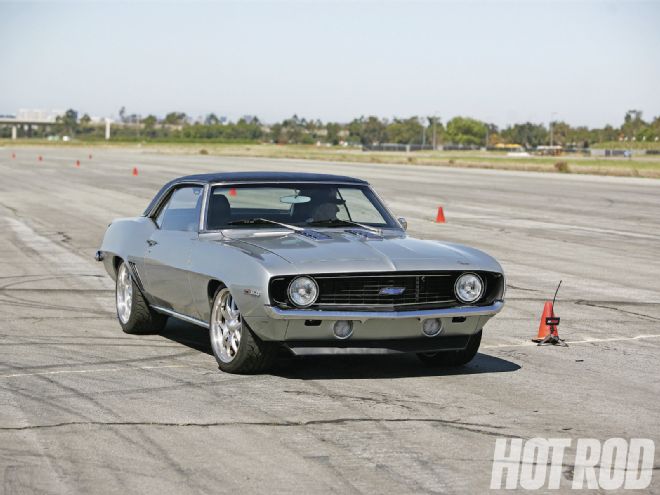
And whether due to street market liability concerns or the outlaw status of ABS in most racing series, the aftermarket has so far failed to develop even a basic electronic ABS retrofit kit, leaving it up to pioneering individuals to point the way. One man who wasn’t afraid to throw away the book is Matt Jones, an engineer at Art Morrison Enterprises. He’s successfully swapped a full ESC system into his ’69 Camaro. Powered by a modern LS engine and shifted by a T56 six-speed, the car’s been thoroughly modernized with a Morrison front subframe and rack-and-pinion steering up front, along with a Morrison three-link supporting a 9-inch Ford rearend out back. The sheetmetal and dash are now about the only remaining original parts.
How It Works
Original, pure ABS stopped wheel lockup and skidding under braking by pulsing the brakes if it detected an incipient lockup condition. Depending on the system’s sophistication, there could be two, three, or four channels (data sensors) that communicated with the brake computer (EBCM or electronic brake control module). Usually found on high-end sports cars, the four-channel systems offer the best response and are easier to retrofit.
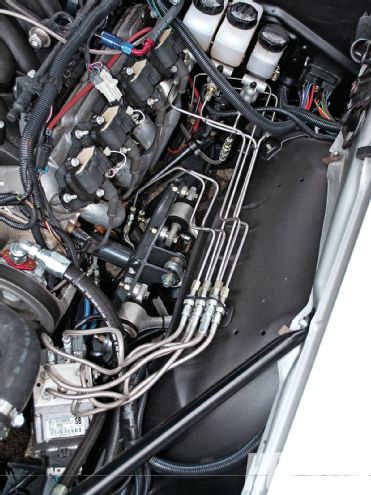 All the experts said it couldn’t be done, but Matt Jones’ daily-driver ’69 Camaro proves them wrong with a transplanted ’02 ZO6 Corvette stability-control system that works just fine with aftermarket Wilwood four-wheel disc brakes and an oval-track tandem master cylinder.
All the experts said it couldn’t be done, but Matt Jones’ daily-driver ’69 Camaro proves them wrong with a transplanted ’02 ZO6 Corvette stability-control system that works just fine with aftermarket Wilwood four-wheel disc brakes and an oval-track tandem master cylinder.
To control vehicle stability in addition to braking, the latest ESC integrates steering angle, yaw, and lateral acceleration sensors into the EBCM. Based on the data from these sensors, plus four-wheel speed sensors, the EBCM software determines if there are any abnormal differences between the speeds of the right and left front and rear wheels. For example, if a car oversteers when cornering and the rearend starts to come around, this increases the speed differential between the left and right front wheels; conversely, understeering results in a loss of front traction, decreasing the left and right wheel speed differential. If the speed differential is outside of normal parameters, the system tries to resolve the problem by applying counter-braking at individual wheels. In production applications, the EBCM may also tie into the engine control unit (ECU). When interconnected, the typical control strategy is to first reduce ignition timing when wheelspin is detected, then reduce throttle angle if the timing reduction didn’t work, and finally apply the brakes to a particular wheel.
Which Donor?
Currently the EBCM can’t be reprogrammed. You’ll need to find a donor car with similar overall weight, front/rear weight distribution, center of gravity, roll rate, and wheelbase. Never use a front-wheel-drive setup on a rear-drive car. Avoid truck units; designed to be much more tolerant of widely varying load conditions (empty or fully loaded), they generally exhibit excessive lag time in a spirited sports car. Although more readily available, a system out of an econobox—even if rear drive—is also less desirable compared with one from a higher-end car like a Camaro, police car, or Corvette.
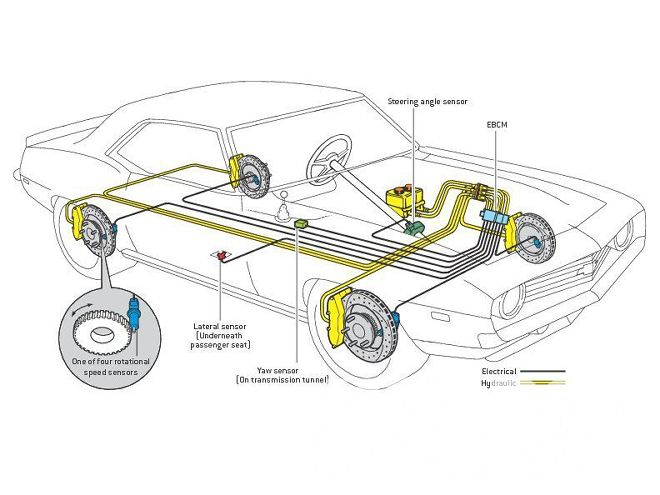 Jones’ Camaro mounts the critical sensors in positions corresponding as closely as possible to their location in the original Corvette donor. The lateral acceleration sensor (which monitors deceleration changes) and yaw sensor (which detects changes in vehicle stability that could cause a spinout) just need a flat mounting surface, but the wheel speed sensors require compatible suspension and brake components and/or custom machining. Mounted on the steering column, the steering angle sensor monitors the steering wheel angle and how fast the column is turned.
Jones’ Camaro mounts the critical sensors in positions corresponding as closely as possible to their location in the original Corvette donor. The lateral acceleration sensor (which monitors deceleration changes) and yaw sensor (which detects changes in vehicle stability that could cause a spinout) just need a flat mounting surface, but the wheel speed sensors require compatible suspension and brake components and/or custom machining. Mounted on the steering column, the steering angle sensor monitors the steering wheel angle and how fast the column is turned.
Jones picked a Bosch ESC used on the ’02 Z06 Corvette as the best solution for his early Camaro. It helped that Jones’ car was already running Morrison’s replacement front subframe that uses the late-Vette suspension—the front knuckles and rotors were already set up to accept the Vette sensors. Overall, Jones feels the Corvette setups are very adaptive to high-performance, similar-weight-class cars. The Z06 EBCM has the most aggressive programming, but the architecture on any ’01 to ’04 Vette should be similar. If all you want is ABS and possibly traction control without full ESC, a ’99 to ’02 F-car (Camaro/Firebird) four-channel EBCM is more available and affordable.
Wheel Sensors
Besides the early GM Camaro/Firebird, Morrison also offers frames or subframes for second-gen F-cars, C1 Vettes, and one-off customs with the Vette suspension and its ABS-compatible steering knuckles (as a company, Morrison doesn’t officially support ABS conversions, though). For those cars still retaining original-style front ends, Speed Tech has bolt-in 6061-T6 forged-aluminum steering knuckles with Vette-type, bolt-in hub assemblies for many older GM cars.
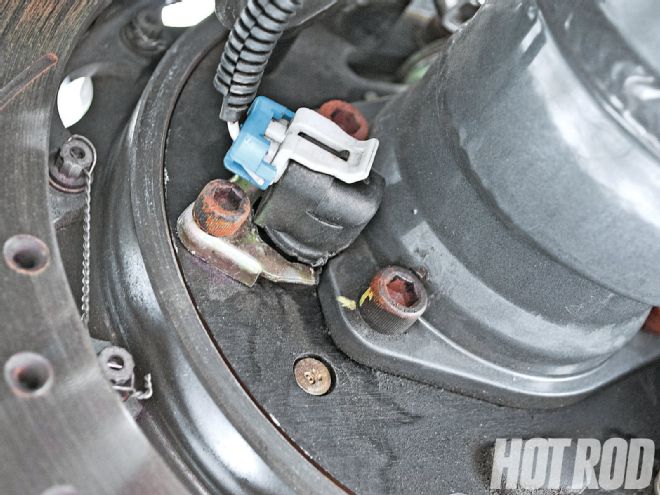 Wheel sensors: Morrison’s front subframe uses C5/C6 Corvette front suspension parts. The Vette knuckles have bolt-on hubs with permanently lubed, encapsulated wheel bearings and the necessary reluctor wheel that mates with the sensor (follow the gray wire, A). Camaro wheel sensors from ’99 to ’02 are used on Strange custom-machined 9-inch Ford axles (B).
Wheel sensors: Morrison’s front subframe uses C5/C6 Corvette front suspension parts. The Vette knuckles have bolt-on hubs with permanently lubed, encapsulated wheel bearings and the necessary reluctor wheel that mates with the sensor (follow the gray wire, A). Camaro wheel sensors from ’99 to ’02 are used on Strange custom-machined 9-inch Ford axles (B).
Old-school knuckles that still take separate, nonsealed wheel bearings must use brake rotors that have the proper clearance for the reluctor wheel. One solution—particularly for old GM A-bodies (Chevelles and clones)—could be knuckles from late-GM B-cars (Impala and clones); the ’94 to ’96 variants with lightweight, four-wheel disc brakes have ABS mounting provisions on the knuckles and integral-hub, 12-inch rotors with the proper clearance. (Redrill the big B-car’s 5-on-5-rotor bolt pattern to match the smaller GM car’s 4-on-4¾–pattern wheels.)
Vettes have an independent rear, but like most muscle cars, Jones’ Camaro runs a solid axle—in his case a 9-inch Ford. Solid rears need the axles machined to accept the ABS reluctor wheel. The Strange axles in Jones’ rear use GM-style, 47-tooth reluctor wheels out of a ’99 to ’02 F-car with traction control. Getting the rear sensor to function properly and clear the parking brake internals and axlehousing mount is, Jones says, “the most difficult part of the whole system. As it turns out, GM has a similar setup to Ford’s rear ABS sensor. Wilwood’s in-hat parking brake is modeled after a Ford, and my Torino-style housing ends are also Ford based, so really the rear setup is like a Ford, only using a GM sensor and reluctor wheel.”
Brake and Tire Sizing
The EBCM predicts and eliminates brake lockup using an algorithm based on the brake system’s downstream (post-EBCM) fluid volume. It assumes that if the EBCM pump moves a certain amount of fluid, the vehicle should decelerate at a given rate. For the preprogrammed assumptions to be valid, the calipers need to have a similar fluid volume as those from the donor car—either the stock originals or similar-volume aftermarket replacements. However, maintaining the same rotor diameter isn’t as critical. Jones’ Camaro uses Wilwood six-piston Z06 Corvette replacement calipers and 14-inch rotors up front, with Wilwood four-piston Pro Street calipers on 13-inch rotors out back.
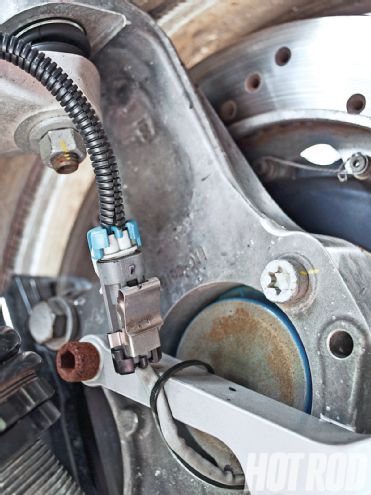 Wheel sensors: Morrison’s front subframe uses C5/C6 Corvette front suspension parts. The Vette knuckles have bolt-on hubs with permanently lubed, encapsulated wheel bearings and the necessary reluctor wheel that mates with the sensor (follow the gray wire, A). Camaro wheel sensors from ’99 to ’02 are used on Strange custom-machined 9-inch Ford axles (B).
Wheel sensors: Morrison’s front subframe uses C5/C6 Corvette front suspension parts. The Vette knuckles have bolt-on hubs with permanently lubed, encapsulated wheel bearings and the necessary reluctor wheel that mates with the sensor (follow the gray wire, A). Camaro wheel sensors from ’99 to ’02 are used on Strange custom-machined 9-inch Ford axles (B).
It is theoretically possible that high-friction compound brake pads could cause wheel lockup before the EBCM pump generates enough pressure to prevent skidding, but in the real world many stock-class road racers are running race pads without serious issues.
If tire diameter varies more than 5 percent from that of the donor car, the traction control may get confused and engage at high speed. You can, however, change the rearend gear ratio without problems. Jones chose tires with diameters similar to the Z06 (275/35R18, front; 295/35R18, rear).
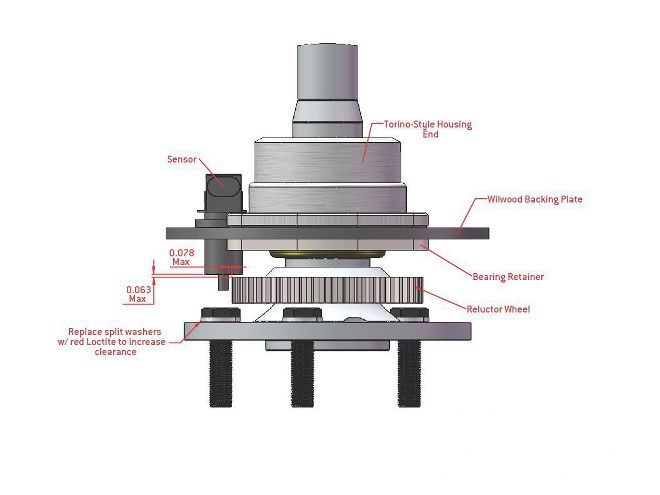 Consider these nominal rear-wheel sensor mounting dimensions for the 9-inch Ford rear as just a starting point. The pickup stud reads the reluctor’s wheel teeth via a change in the magnetic field (the change frequency equates to road wheel speed). The axle hub’s bolt heads can confuse the sensor—position the sensor stud far enough away from the axle flange but close enough to the reluctor wheel to receive a reliable signal. In a cut-and-try process, Jones had to remove the bolt washers, shave the bolt heads, shorten the sensor stud a little at a time, and tighten up the air gap.
Consider these nominal rear-wheel sensor mounting dimensions for the 9-inch Ford rear as just a starting point. The pickup stud reads the reluctor’s wheel teeth via a change in the magnetic field (the change frequency equates to road wheel speed). The axle hub’s bolt heads can confuse the sensor—position the sensor stud far enough away from the axle flange but close enough to the reluctor wheel to receive a reliable signal. In a cut-and-try process, Jones had to remove the bolt washers, shave the bolt heads, shorten the sensor stud a little at a time, and tighten up the air gap.
Master Cylinder
What about upstream of the EBCM? In Jones’ experience, the EBCM “really doesn’t seem to care.” Assuming sufficient capacity and pedal advantage to support the system’s hydraulic needs, the master cylinder, power booster, and brake pedal are, to a large degree, up to the end user’s discretion. In a big departure from the original Vette factory cylinder and power booster, Jones uses an extreme Wilwood oval-track tandem manual master and pedal assembly with no problems. He could just as well have used an old ’69 production power booster and dual master cylinder (with any drum brake RPV removed from the latter) or even the late-model Vette aluminum master cylinder and booster.
ABS systems don’t rely on mechanical break biasing methods, so Jones set the tandem cylinder’s balance bar in the neutral position. Similarly, discard any separate in-line proportioning valve left over from the car’s original brake system.
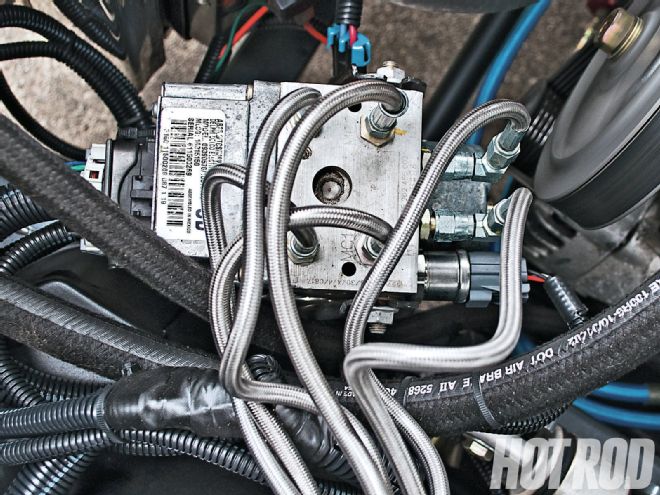 Jones mounted the EBCM on the driver-side inner fender, below the master cylinder level. Each EBCM fluid port is stamped for function. Plumb each wheel separately (no tees). If you’re a hardline and plumbing freak, this job’s for you!
Jones mounted the EBCM on the driver-side inner fender, below the master cylinder level. Each EBCM fluid port is stamped for function. Plumb each wheel separately (no tees). If you’re a hardline and plumbing freak, this job’s for you!
Plumbing and Wiring
Besides the computer and sensors, try to grab the donor car’s wiring harness and plumbing. Much of this can be adapted to your project. Even if fabrication is needed, it will serve as a guide to show how everything hooks up. Multiwire electrical connectors have numbers or letters that correspond to the donor car’s wiring diagram. These diagrams can be found in the factory service manual (available in paper or on CD from Helm) or by online subscription to www.Alldata.com.
If building a harness from scratch, connectors, terminals, and even preterminated pigtails are available from your GM dealer, ACDelco, or Mouser. Del City and Waytek offer affordable high-quality bulk wire. Whether a modified takeout harness or scratch-built original, it must tie into the original car’s electrical system. The diagram (pg. 100) shows which computer terminals need external battery or ignition power.
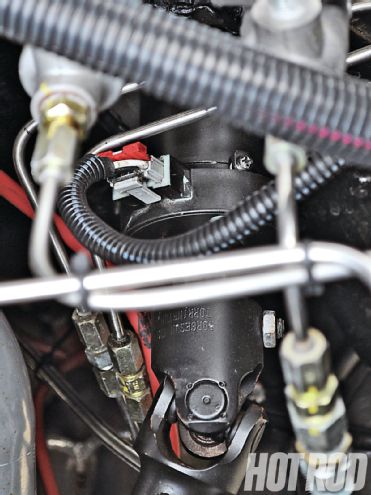 The donor Vette had a 1-inch-DD steering shaft just like the Camaro’s Flaming River unit, so its steering angle sensor slid right on. A machined aluminum collar supports the end of the shaft; it has a drilled and tapped hole to lock the sensor in place. The sensor requires a zero index, so the whole steering system must be carefully aligned during assembly.
The donor Vette had a 1-inch-DD steering shaft just like the Camaro’s Flaming River unit, so its steering angle sensor slid right on. A machined aluminum collar supports the end of the shaft; it has a drilled and tapped hole to lock the sensor in place. The sensor requires a zero index, so the whole steering system must be carefully aligned during assembly.
Performance So Far
So far, Jones hasn’t hooked up the EBCM to the ECU, relying only on brake modulation to control vehicle stability. The only problem in more than 6,000 miles of street and track driving is on the racetrack, where the stability control kicks in a bit early, limiting the car’s cornering ability to about 0.9 g (as opposed to 1.0 g without it). So for track day, Jones simply disconnects the lateral acceleration sensor.
A big issue for the can’t-be-done crowd was how a retrofit system performs in ice mode. In theory, if the brakes think every wheel is driving under icing conditions, it could keep them from locking up. Jones lives in snowy Washington state and hasn’t seen this problem in the real world. “I’ve driven in the rain and snow—everything’s perfect.”
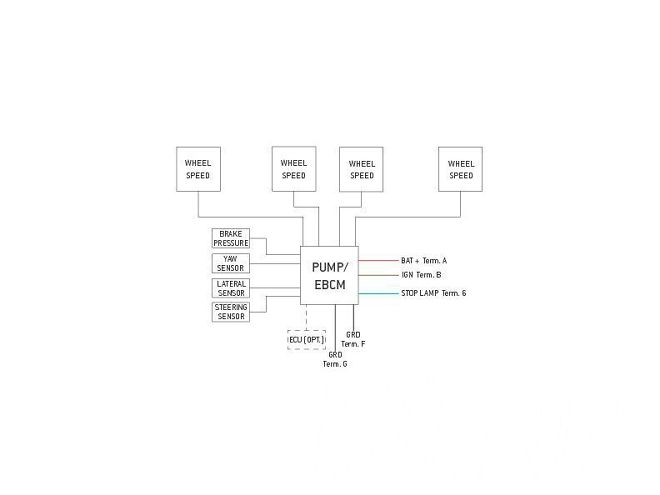 Basic wiring: Everything goes to or from the EBCM. The brake pressure sensor bolts onto the Vette EBCM; it may be remotely mounted on other cars. With an existing donor car harness, the basic interface hookups needed are two fused power wires (one hot at all times, one hot in ignition “on”) and two ground wires. Splice the stoplamp wire into the stoplight circuit. Hooking up the brake computer to the ECU (engine computer) is optional. The terminal numbers are for an ’05 Vette EBCM; others models may vary. HRM
Basic wiring: Everything goes to or from the EBCM. The brake pressure sensor bolts onto the Vette EBCM; it may be remotely mounted on other cars. With an existing donor car harness, the basic interface hookups needed are two fused power wires (one hot at all times, one hot in ignition “on”) and two ground wires. Splice the stoplamp wire into the stoplight circuit. Hooking up the brake computer to the ECU (engine computer) is optional. The terminal numbers are for an ’05 Vette EBCM; others models may vary. HRM
In sum, Jones has found that ABS/ESC systems prove surprisingly robust when installed correctly by a knowledgeable hot rodder, disproving more than a quarter century of naysaying. But as with any brake system, each installation needs to be validated at the track or in a deserted parking lot before taking it to the streets on cruise night.